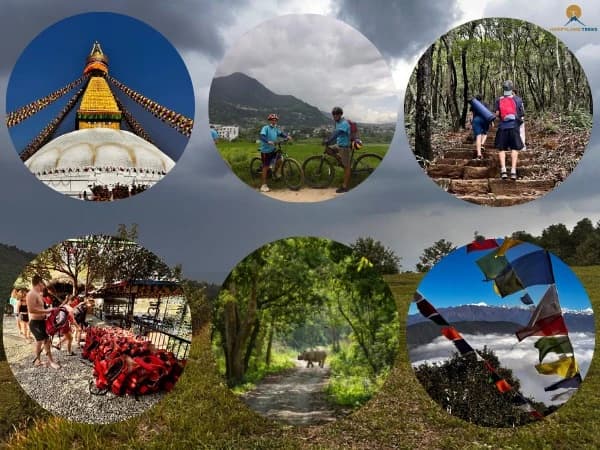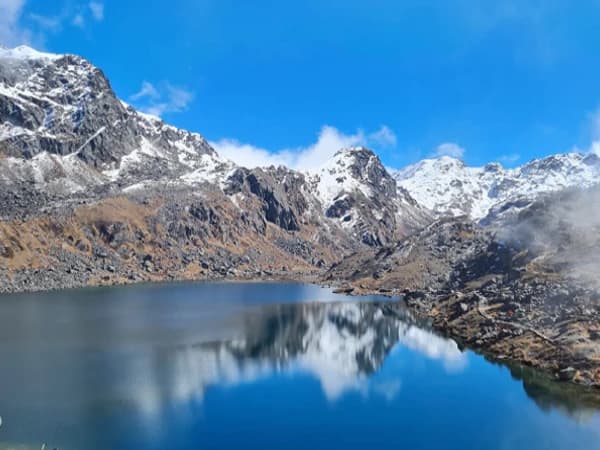The journey to Annapurna Base Camp was a personal highlight. The charming trails leading into the Annapurna Sanctuary were lined with prayer flags, rhododendrons, and the occasional tea house serving hot dal bhat. At Base Camp, I took in panoramic views of Mt. Annapurna, Mount Annapurna, and the whole Annapurna Mountain Range. It was cold and bad weather had rolled in a few times, and I was grateful for every layer I packed but worth every step.
If you're up for more, I highly recommend the Annapurna Circuit, an 81-mile trekking route that loops through various landscapes and cultures. The circuit trails are not just scenic and they're soul-changing. Along the way, you’ll meet locals, fellow trekkers, and even high-altitude Sherpa preparing to support the next summit team.
This area has an incredible mountaineering history too. I stood at viewpoints where the likes of Chris Bonington, Ian Clough, and Craig Anderson once stood. I heard stories of the famous French expedition of 1950, the first to reach the summit of Annapurna I, and how Tenzing Norgay, long before his Mount Everest glory, had walked these very ridges. Even the German expedition left its mark here.
The entire trek was a lesson in resilience and respect. You’ll hear avalanches in the distance, face cold weather, and watch clouds swallow entire valleys in minutes. But you'll also share laughs with porters, sip butter tea with strangers, and walk beneath some of the most beautiful skies you’ll ever see.
So if you’re planning to explore Annapurna Treks, let me tell you, it’s more than just a trip. It’s a journey of discovery. Whether you're heading for Annapurna Base Camp, challenging yourself with the Annapurna Circuit, or simply soaking in the serenity of the Annapurna Conservation Area, you’ll walk away with more than just photos. You’ll take home a part of the Himalayas with you.
Best Time to Visit Annapurna
Autumn (September – November)
This is when I went, and I highly recommend it! The skies are clear, the views are sharp, and the weather is just right—cool mornings, warm days. It’s also the peak season, so the charming trails are lively with trekkers from around the world.
Spring (March – May)
Another great time, especially if you love flowers. The rhododendron forests in full bloom along the Annapurna Circuit or the path to Annapurna Base Camp are unforgettable. The visibility is great, and temperatures are more moderate than winter.
Avoid Monsoon (June – August)
The trails can get muddy, bad weather is common, and unpredictable weather makes mountain views rare. Landslides are also a concern.
Winter (December – February)
If you're okay with cold weather, winter can be peaceful. But many high passes close due to snow, and climbing routes become more dangerous.
Preparation Tips Before You Go
- Train for it: Cardio, leg workouts, and long hikes helped me a lot. Even though the trek is doable, the altitude and long days can be tough.
- Learn basic Nepali phrases: Even a simple “Namaste” goes a long way.
- Respect the culture: The Annapurna region is filled with ancient traditions. Always ask before taking photos, especially in temples or homes.
- Go with the flow: Weather, trail conditions, or even your summit team’s pace might affect your plan. That’s part of the beauty.
Bonus Tip: Helicopter Option
If you’re short on time or want to treat yourself, there are -way Helicopter flights available from Annapurna Base Camp back to Pokhara. It’s pricey but worth it for the views and comfort.
FAQs
1. Is the Annapurna Base Camp Trek hard?
Not too hard, but not too easy either. I’d say it’s moderately challenging—good for beginners who are in shape and fantastic for adventure trip lovers. The altitude is what really tests you, so go slow and give your body time to adjust.
2. How long does the trek take?
The Annapurna Base Camp Trek took me about 7–10 days, depending on the pace and side trips. If you're doing the Annapurna Circuit, budget around 2–3 weeks, especially if you include Poon Hill or Tilicho Lake.
3. Do I need a guide or porter?
It’s not required, but highly recommended. I hired a high-altitude Sherpa who not only carried some of my gear but also shared amazing local stories. Plus, the guide handled permits and knew how to deal with sudden bad weather or unpredictable weather.
4. What permits do I need?
You’ll need two:
- TIMS Card (Trekkers’ Information Management System)
- ACAP Permit (Annapurna Conservation Area Project)
Your guide or local agency usually arranges these for you.
5. Can I get altitude sickness?
Yes, and I felt a mild headache around 3,000 meters. That’s why I always tell people to take it slow, drink lots of water, and rest when needed. Know the symptoms and don’t push it. Many brave mountaineers have had to turn back just before the summit party for safety and that’s okay.
6. Is accommodation available along the trail?
Yes! There are plenty of accessible accommodations like tea houses. They’re basic but cozy, and most offer home-cooked meals. Just be ready for occasional extra charges like battery charges, hot showers, or Wi-Fi.
7. What's the food like?
Delicious and hearty! You'll live on dal bhat, momos, soups, and tea. It’s simple but gives you all the energy you need for trekking. After a long day on the charming trails, there’s nothing better than a hot plate of local food in a mountain village.
Conclusion
If you’ve ever dreamed of walking among giants, tracing the footsteps of legends like Tenzing Norgay, Chris Bonington, Ian Clough, or the fearless French expedition, then the Annapurna Himalayas are waiting for you.
From the holy meaning of Mount Annapurna the goddess of food to the wild, raw beauty of the Annapurna Sanctuary, this trek isn’t just a vacation. It’s a journey through history, nature, and self-discovery. Whether you’re following the footsteps of a British climber on a historic Climbing route, gazing at satellite peaks, or enjoying the stunning views after a long climb, this experience stays with you forever.
I’ve walked those circuit trails, felt the chill of cold weather, sat beside summit teams planning their next move, and shared warm tea with locals deep in Gandaki Province. And if I can do it and you can too.
So pack light, train a bit, and bring a curious heart. Annapurna will take care of the rest.



